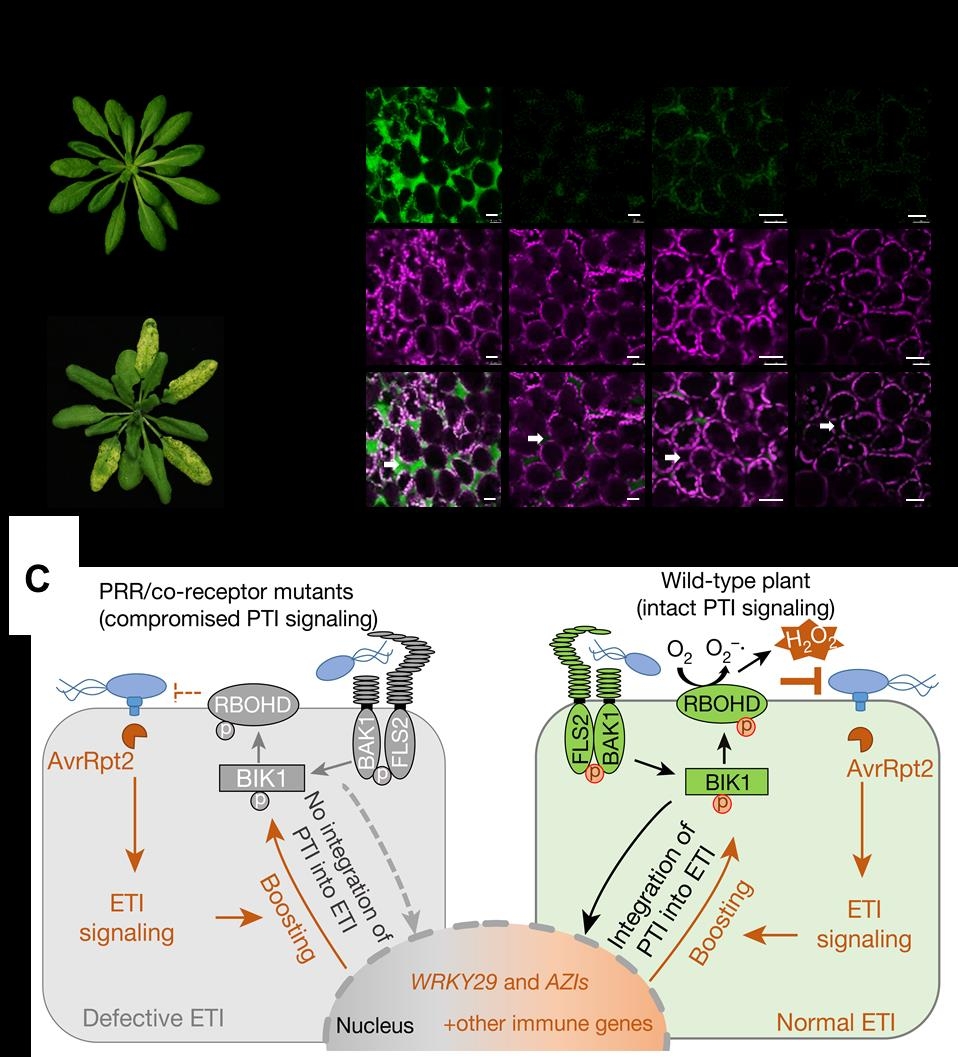Understanding the Architecture of Plant Immune System
In nature, plant have evolved a two-layered immune system to protect themselves against diverse pathogens, including bacteria, fungi, oomycetes and so on. The first layer of the immune system is the immunity triggered upon recognition of the pathogen-associated molecular patterns (PAMPs) via cell surface-localized pattern recognition receptors (PRRs), and is called pattern-triggered immunity (PTI). The second layer of the plant immunity is triggered by activation of intracellular immune receptors, Nucleotide-binding, Leucine-rich Repeat proteins (NLR), through direct or indirect recognition of pathogen effectors, and is known as effector-triggered immunity (ETI). A large number of previous studies showed that PTI and ETI have significant differences in signaling initiation and early transduction events, and therefore have traditionally been considered to act independently. However, the relationship between the two pathways was not clear, representing a knowledge gap towards a full understanding of plant immunity.
On March 11st, 2021, the prestigious international journal Nature published a research article from Dr. Xiu-Fang Xin’s group at CAS Center for Excellence in Molecular Plant Sciences (CEMPS), entitled: “Pattern-recognition receptors are required for NLR-mediated plant immunity”. In this work, the authors discovered the functional association between the two primary immune pathways, PTI and ETI, in plants.
This study showed that PRR mutants, which lack PTI signaling, are surprisingly also compromised in ETI responses. They found that PTI pathway activation is crucial for ETI-associated reactive oxygen species (ROS) production. ETI-triggered ROS production is mainly mediated by RBOHD, a NADPH oxidase. Interestingly, the authors found that ETI can significantly upregulate the mRNA and protein level of RBOHD in a PTI independent manner, but the full activation of RBOHD during ETI depends on PTI signaling. Therefore, the PTI and ETI pathways work together to regulate RBOHD and production of ROS. Furthermore, the authors found that ETI strongly up-regulates the transcript and protein levels of many key signaling components of PTI. This study demonstrated the exquisite synergistic mechanism between PTI and ETI pathways and that PTI is actually an indispensable component of ETI, providing a new perspective to understanding the plant immune system. Meanwhile, this study explains the long-observed puzzle of largely overlapping downstream outputs between PTI and ETI over the years and suggests new strategies of improving plant resistance to numerous diseases by integrating two pathways.

Fig. Main findings in the article. A, The phenotypes of resistant and susceptible plants after bacterial infection. B, The ROS production in plants treated by different bacteria. Wild-type Col-0 plants treatment with D36E(avrRpt2) strain can activate both PTI and ETI. bbc, PTI mutants. Green fluorescence indicates ROS, and purple fluorescence represents autofluorescence of chloroplasts. Fig C. A model depicting the findings from this study, showing PTI as a key component of ETI. In wild-type plants (right), RPS2 activation leads to protein accumulation of key PTI components, including BIK1 and RBOHD, and potentiation of PTI-associated genes such as WRKY29 and AZIs. PRR/co-receptors are required to fully activate ROBHD (by phosphorylation) to generate robust ROS and normal ETI. In the absence of PRR/co-receptors (left), although NLR activation still induces PTI components, many of these components, such as BIK1 and RBOHD, are inactive, leading to lack of ROS production and defective ETI. Mutated (that is, FLS2 and BAK1) or inactive (that is, RBOHD and BIK1) proteins are colored grey and active proteins are in green.
Article link:
https://www.nature.com/articles/s41586-021-03316-6
Contact:
Dr. Xiu-Fang Xin, Group leader
National Key Laboratory of Plant Molecular Genetics(NKLPMG)/ CAS-JIC Center of Excellence for Plant and Microbial Sciences (CEPAMS), CAS Center for Excellence in Molecular Plant Sciences (CEMPS), Chinese Academy of Sciences
Tel: 86-21-54924354
Email: xinxf@cemps.ac.cn